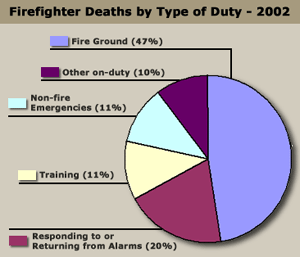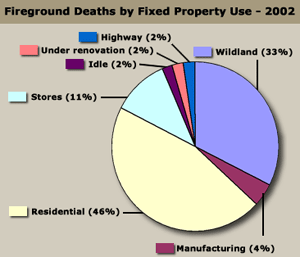
 message
boards message
boards
chat
feedback

|
|
  
|
|
Firefighter
Fatalities in the United States -- 2002
Excerpted from a report compiled by Paul R. LeBlanc and
Rita F. Fahy
|
|
|
Each year, NFPA collects data on all
firefighter fatalities in the U.S. that resulted from injuries or
illnesses that occurred while the victims were on-duty. The victims
include, besides members of local career and volunteer fire
departments, those seasonal and full-time employees of state and
federal agencies who have fire suppression responsibilities as part
of their job description, prison inmates serving on firefighting
crews, military personnel performing assigned fire suppression
activities, civilian firefighters working at military installations
and members of industrial fire brigades.
In 2002, a total of
97 on-duty firefighter deaths occurred in the U.S. This compares to
the 440 firefighter fatalities that occurred in 2001 (340 at the
World Trade Center on September 11 and 100 elsewhere in the
U.S.).
|
| While, in 2001, the U.S. fire service experienced its most
catastrophic year, in terms of on-duty firefighter fatalities, in
2002, the death toll fell back to the level experienced over the
past decade. At 97, the total number of on-duty deaths was slightly
below the most recent five-year average of approximately 100 deaths
per year. |

|
In 2002, many areas across the U.S.
experienced one of the worst wildland fire seasons in recent years,
and unfortunately, as a result, it was a particularly bad year for
wildland firefighter fatalities. A total of 22 firefighters died
while working at or responding to wildland fires or at a controlled
burn. Three of the five largest loss-of-life incidents involved
wildland firefighter fatalities.
There were a couple of
positive findings in 2002. No career firefighters died while
responding to or returning from emergencies, and there were fewer
than the average number of deaths involving volunteer firefighters
responding in private vehicles. One year does not indicate a trend,
but it's a positive finding that we hope will
continue.
|
| But many of the same problems continue to exist, particularly
the large number of firefighters who died of heart attacks. Again in
2002, heart attacks were the leading cause of on-duty firefighter
deaths, and we continue to find that most victims for whom medical
documentation was available had pre-existing health problems. |
 |
The frequency of these fatalities and other
fire ground and training deaths can be reduced by adopting and
adhering to a comprehensive safety and health program designed using
NFPA 1500, Standard on Fire Department Occupational Safety and
Health Program, and its companion standards, and NFPA 1403, Standard
on Live Fire Training Evolutions. NFPA 1582, Standard on Medical
Requirements for Fire Fighters and Information for Fire Department
Physicians, lists the medical conditions that prevent an individual
from serving effectively and safely as a firefighter and so preclude
individuals from working as suppression firefighters. Attention to
fitness and health throughout every firefighter's years of service
is essential.
Credits: The study was
made possible by the cooperation and assistance of the United States
fire service, the Public Safety Officers' Benefits Program of the
Department of Justice, the United States Fire Administration, the
National Institute for Occupational Safety and Health, the Forest
Service of the U.S. Department of Agriculture, and the Bureau of
Indian Affairs and the Bureau of Land Management of the U.S.
Department of the Interior. The authors would also like to thank
Stephen N. Foley and Carl E. Peterson of the Public Fire Protection
Division for their assistance on the study. |
|
| "Fittest Firewoman" Offers Tips on Maintaining Health
& Fitness |

A recent issue of Outside magazine
featured a story on Juliet Draper, who the publication billed
as the "fittest firewoman alive."
Draper,
who is a firefighter and paramedic in Colorado trains members
of Team Firejock for competition in the Scott Firefighter
Combat Challenge. In an interview with WN&N, Draper
offered her viewpoints on staying fit. |
|
WN&N: How do you define being
fit?
JD: Fitness is gaining and maintaining the
capacity to do the job whenever and wherever it happens. There
are several components to fitness: muscular strength and
endurance, cardiovascular strength and endurance, flexibility,
nutrition, adaptability, and work capacity, to name a
few.
WN&N: What are the obstacles to fitness
that firefighters face?
JD: Firefighters typically
face the same obstacles as the rest of America: "Not enough
time," "I'm tired after work," "But I don't like veggies!" The
list is endless. Consequently, the same things that kill most
people are the same things that shorten our lives. The number
one is heart disease…You know, heart attacks are the number
one killer of firefighters. They're usually caused by a
combination of genetics, lack of exercise, improper nutrition,
and poor stress management. My doctor once told me that if
people quit smoking, ate right, and exercised, 80 percent of
her business would be gone! While there's little we can do
about genetics, we can stay healthy longer if we tackle the
things we can do something about.
|
WN&N: How can firefighters gain
and maintain fitness?
JD: Lifestyle changes are what I
recommend to gain and maintain firefighter fitness. Lifestyle
changes happen a little at a time. Trying to change too many
habits at once is a prescription for failure. We believe in
achieving functional fitness 21 days at a time. Make one
change and then add something new every 21 days. For example,
start an exercise program today. Twenty-one days later, bring
your water intake up to 8 to 10 glasses per day. Twenty-one
days later, add three cups of vegetables to your daily
routine. Whenever you add something, something else falls
away. And it's important to remember that it's a lifetime
program. So, take it slow and make it stick.
WN&N: What's the best way to maintain fitness
and health with a limited schedule?
JD: The best ways
to maintain fitness and health with a limited schedule is to
prioritize the areas that need the most improvement. If your
cardio is weak, focus on the cardio in a job specific manner.
For wildlanders that means throwing on a weighted vest or
backpack, grabbing your Pulaski, and going for a hike. And
remember, start 'slow and low' and build gradually.
WN&N: What role does nutrition play in fitness?
JD: Nutrition is one of the most important aspects of
fitness, if not the most important. Food is what fuels the
machine. It's important to get plenty of water, fruits and
vegetables and to limit refined foods and sugars. We adhere to
a high protein, low carbohydrate way of life, getting most of
our carbs from fruits and leafy green vegetables, and we
schedule our favorite treats monthly. For example, we love Red
Robin burgers and have one every six weeks.
WN&N: How important are strength and endurance
when training?
JD: Strength and endurance are equally
important and they are complementary. In order to be a
well-rounded and capable firefighter you must have both.
Circuit training is an excellent and efficient way to develop
both these areas of fitness, and it provides the muscular and
cardiovascular endurance wildlanders need.
WN&N: What are good methods for stress relief?
JD: For stress relief I recommend something fun. Play
your favorite sport, take a long walk or hike in nature, or
take yoga classes. Whatever you do, take deep breaths
throughout the day. In addition to exercise, add fishing,
hunting, long baths, reading, movies or any enjoyable activity
- even doing nothing.
To learn more about Juliet
Draper and her Firejock training program, check out her
website at http://www.firejock.com/.
| |
|
  
| |





 message
boards
message
boards